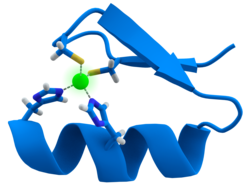Metalloprotein
A metalloprotein is a protein with a metal ion cofactor.[1] Many proteins are members of this category, so the number of them is large.
It is estimated that about half of all proteins contain a metal.[2] In another estimate, about one-quarter to one-third of all proteins need metals to carry out their functions.[3] Thus, metalloproteins have many different functions in cells, such as enzymes, transport and storage proteins, and signal transduction proteins.
Metalloprotein Media
Rubredoxin active site.
The copper site in plastocyanin
Active site of carbonic anhydrase. The three coordinating histidine residues are shown in green, hydroxide in red and white, and the zinc in gray.
Zinc finger. The zinc ion (green) is coordinated by two histidine residues and two cysteine residues.
References
- ↑ Shriver, D.F; Atkins P.W. (1999). "Chapter 19, Bioinorganic chemistry". Inorganic chemistry (3rd ed.). Oxford University Press. ISBN 0-19-850330-X.
- ↑ Thomson A.J. & Gray H.B. 1998. "Bio-inorganic chemistry". Current Opinion in Chemical Biology. 2, 155-158.
- ↑ Waldron K.J. & Robinson N.J (2009). "How do bacterial cells ensure that metalloproteins get the correct metal?". Nat. Rev. Microbiol. 7 (1): 25–35. doi:10.1038/nrmicro2057. PMID 19079350. S2CID 7253420.






